A product manager portfolio is an important piece of the puzzle to ensure that you’re on the right track to success.
So you’ve completed a product management course or program and have worked on some projects to get familiar with a range of industry tools—you may even have a certification.
Maybe you’re already adding the finishing touches to your product manager resume, and now you’re wondering what’s next.
Well, before you start preparing for and rehearsing answers to common PM interview questions, there’s the small matter of where to showcase your projects first.
In this guide, you’ll learn just what a product manager portfolio is, why career changers in particular need them, and how to create a great one.
If you need to skip ahead to a section, simply use the clickable menu:
- Do product managers have a portfolio?
- How to make a product manager portfolio
- What makes a good product manager portfolio?
- Nine inspiring product manager portfolio examples
- Final thoughts and wrap-up
Are you ready to get into it? Then let’s begin!
1. Do product managers have a portfolio?
Many product managers who have been around for a few decades in the industry might tell you that they never needed a product manager portfolio to bag a job.
However, the game has changed.
While portfolios are more common in the fields of UX and web development, they’re becoming a growing feature in the product field as well.
One of the main reasons why they have taken longer is scope. By its own nature, it can be a lot harder for product managers to encapsulate their accomplishments and skills in this format. But it certainly is not only possible, it’s also worth it!
For those changing careers into product management, a product manager portfolio becomes less of a nice-to-have and more of a necessity. While you might not have a huge amount of on-the-job experience in the role, it’s an excellent way of demonstrating the skills which you’ve picked up and then honed.
Instead of a burden, it’s a secret weapon, giving you an extra platform to catch the eye of hiring managers and showing them you’re up to scratch and worthy of consideration. A great product manager portfolio will instantly show the recruiter what you’re about as well as what you can do.
While you can craft a product manager portfolio for most industries, if you’re looking to apply for roles in the tech industry, then an eye-catching portfolio website is a great advantage.
2. How to make a product manager portfolio
First up, it’s important to say that product managers don’t have design-style portfolios.
This isn’t to say that what you create should be entirely plain and visually unappealing! But don’t spend too much time making it look flashy. As always, it’s the strength of what’s inside that counts.
In terms of how to make your product management portfolio, here’s a simple guide:
Treat it like a project
Approach it like the product manager you are—draw up a plan, and set metrics and goals before you start out.
What are you looking to achieve? Who is the customer? How many portfolio views, interviews, and job offers are you expecting, and with which portfolio format?
By seeing your portfolio in this way, you’re not only making it easier to be motivated and approach it with your professional eye, but you can easily get meta about the whole project. If your portfolio could do with some more material, you can add the planning and making of the portfolio itself. This way, prospective employers will be able to see your processes and how you work.
If you’ve planned and created something you’re proud of, why not share it?
CareerFoundry Product Management Program grad Irena Medlin is a great example of this. As part of her Product Management Immersion course, the former hostel founder completed a capstone project about the Sync video conferencing software, which she then included in her portfolio.
Choose your products wisely
What goes into your product manager portfolio? Well, naturally that depends on which projects you’ve been working on.
Try to include a broad range of elements, in the order of when you worked on them. If possible, make sure to demonstrate your range of experience.
If, on the other hand, you have already worked out which niche or area of the industry you’re going to be applying to (for example SAAS companies in the tech sector), then it makes sense to include the most relevant products first.
Focus on the PRDs
The most important document you’ll need as a product manager is a product requirements document (PRD). This document describes the product’s objectives, features, design, metrics, and so on.
Being able to demonstrate that you can create an effective PRD in both lean and MVP forms is key for prospective employers to show that you’ve got the chops.
Don’t forget to include your own details
Sure, your portfolio will be working in tandem with your resume and cover letter for job applications, but make sure to briefly remind them of who you are.
It sounds obvious, but don’t forget to include links to your social media accounts. The chances are very high that the recruiter will just be skimming through your portfolio at first, so don’t make them work to find your details or how to contact you!
Don’t forget structure
It can be easy to overlook structure in favor of getting straight to your products and PRD, but that’s a mistake!
Make sure to add a clear Table of Contents at the beginning of your portfolio. The content should be as easy as possible for the hiring manager or recruiter to look through, even to skim.
Throughout the entire process of building your product manager portfolio, put yourself in their shoes as they review it. It should really help make sure that it’s as effective as possible.

3. What makes a good product manager portfolio great?
Okay, so we’ve gone through some of the key things you should include in your product manager portfolio so that it’s up to scratch. But how do you go about making sure that yours really stands out?
The following are a few tips to help you achieve that aim:
Slick design
Use a visual tool such as Canva or Figma to create a visually appealing product manager portfolio.
If, however, you’re stuck or find the other options a little too confusing or time-intensive, don’t worry. The likes of Microsoft Word or even a Google Slides deck will also do in a pinch.
An appraisal of yourself as a candidate
While we talked earlier about including your details, it also helps to go a bit further to give the person reviewing your portfolio a better idea.
Include a brief, visually clear profile of your strengths, weaknesses, your skills, and expertise.
Up-to-date skills
Make sure that your product manager skills are relevant when you’re including them in your resume and product manager portfolio. Sure, being proficient in Microsoft Word was seen as pretty nifty in 2005, but times have changed.
A great way to make sure you’re on the right track? The best product management bootcamps will teach the top industry skills and list them on their websites.
As well as that, check out the LinkedIn pages of popular product managers to see what they themselves list. You’ll be surprised how much you can learn about the current state of the industry from researching which skills they’re talking about.
Case studies
This is another way to give yourself an edge.
Remember your audience again when you get to this section—how much time will they spend? The bitter truth, unfortunately, is not that much. So, as a result, make sure that your case studies are presented clearly and are easy to digest.
What are the most important points that they’re looking for? Make sure that for each project your work process is detailed concisely.
As your product management career continues, you’ll soon be able to add more and more case studies. At this point, it becomes a matter of selecting the ones based on your desired outcome—where are you seeking to get hired? What kind of products would you like to work with?
Testimonials
If you have them (and they’re worth getting), these are a great way to set your product manager portfolio apart.
Just as what you’ve done is important, so too is having some social proof to back that up. Being able to include the statements of multiple stakeholders testifying to your product management capabilities is a huge asset.
For career-changers, if you don’t have any strictly product management experience yet, don’t worry. You can still add testimonials to your portfolio!
Simply look at some of your PM skills (not just hard skills but also soft skills), I’m sure that you’ve demonstrated some of these in a previous role or on a project. Go and find the other people or clients you worked with, and ask them to supply you with a testimonial.
This opportunity is more possible for product management than almost any other area in tech. Almost everyone has managed a project with multiple stakeholders at one stage or another, or displayed organizational or people-coordination skills. These are very relevant—don’t forget that!
At the end of the day, potential employers aren’t just interested in the skills and tools you’ve listed, but that you can be trusted to guide their product or service through the life cycle. Testimonials are a great way to prove your trustworthiness.
CTAs
We discussed this earlier, but it’s worth repeating—recruiters and hiring managers will only be scanning your PM portfolio.
Therefore, make sure that you can “convert” them as easily as possible. Ensure that whatever way you’ve designed your portfolio, users are never far away from a CTA button.
What this button does, whether it moves them to your email address (recommended) or pushes them to connect with you on LinkedIn, depends on which audience you plan on reaching with your portfolio.
4. Nine inspiring product manager portfolio examples
Now that we’ve gone over how to make your portfolio and how to make it great, let’s take some inspiration from elsewhere in the field.
Rian van der Merwe
An experienced product manager and Head of Product, Rian has used their own website as their portfolio page.

Things we like: Note that Rian has put their main skills at the top of their introduction, followed swiftly by a link to their LinkedIn profile.
This gives you a great idea of who they are and what they’re great at. The mixed media used as they go through their work experience (from blog posts to gifs of products launched to information architecture charts) is also very helpful and appealing.
Laura Zermin
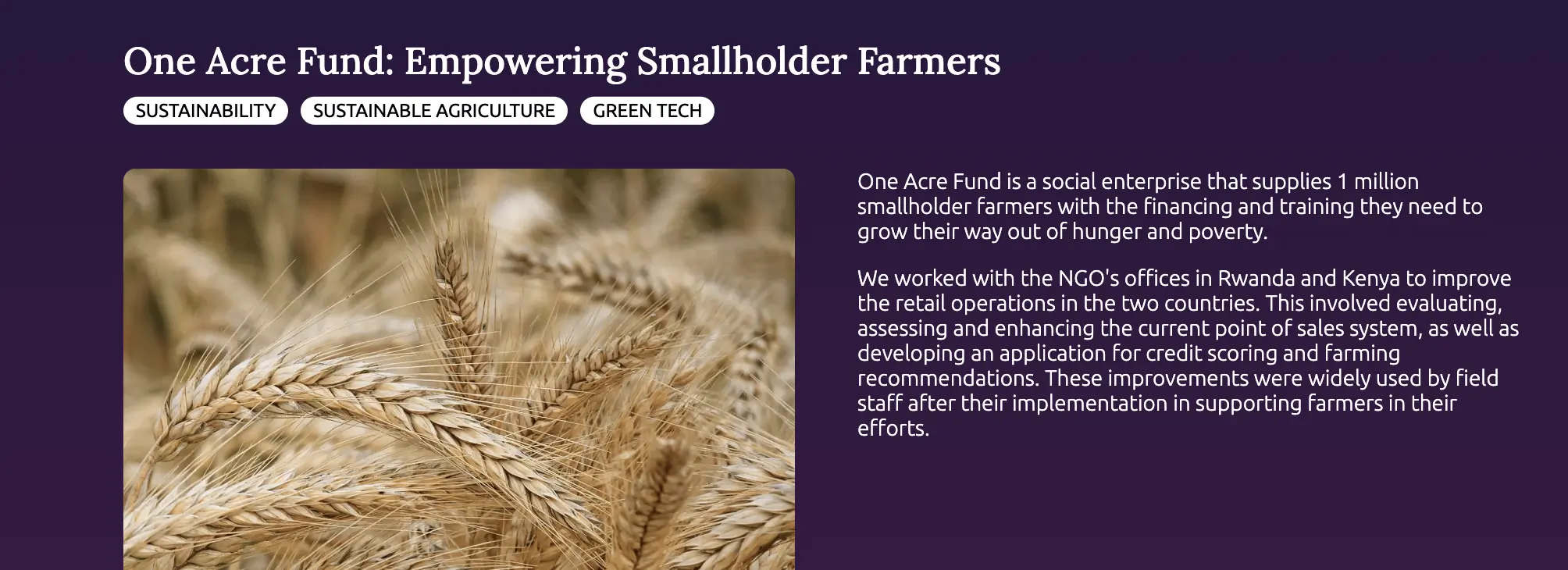
Things we like: How Laura shows off exact the type of product management she has made her own—products that solve real-world problems, in sustainable development and emerging markets.
A freelance product manager based in Germany, Laura’s portfolio website is visually impressive in its use of contrast colors, as well as its simple but effective messaging.
Luis Jurado
A busy website in terms of design, this product manager and agile coach is very easy to contact.
All of his socials (Whatsapp, LinkedIn, GitHub, Instagram, and Twitter) are constantly accessible in the bottom-left corner of his website, no matter where you scroll. Also, pay attention to his testimonial section—short and numerous!
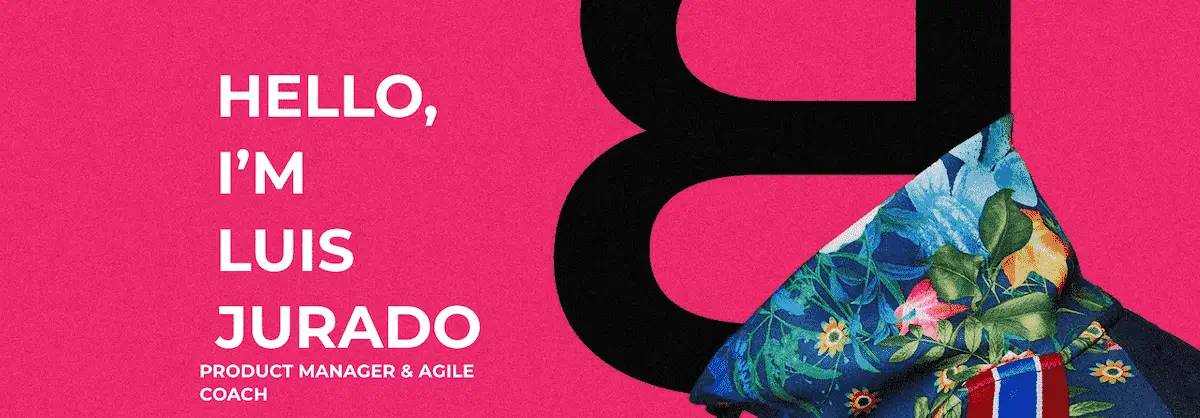
Things we like: Luis uses icons to help communicate his skills and the tools he uses at a glance.
Displaying the exact percentages of his skills is a step too far (unless you actually can numerically quantify your skills in e-commerce), but the idea is great.
Thaisa Fernandes
A person of many hats, Thaisa’s product management section of her website contains more than a few neat elements to inspire you when creating your own.
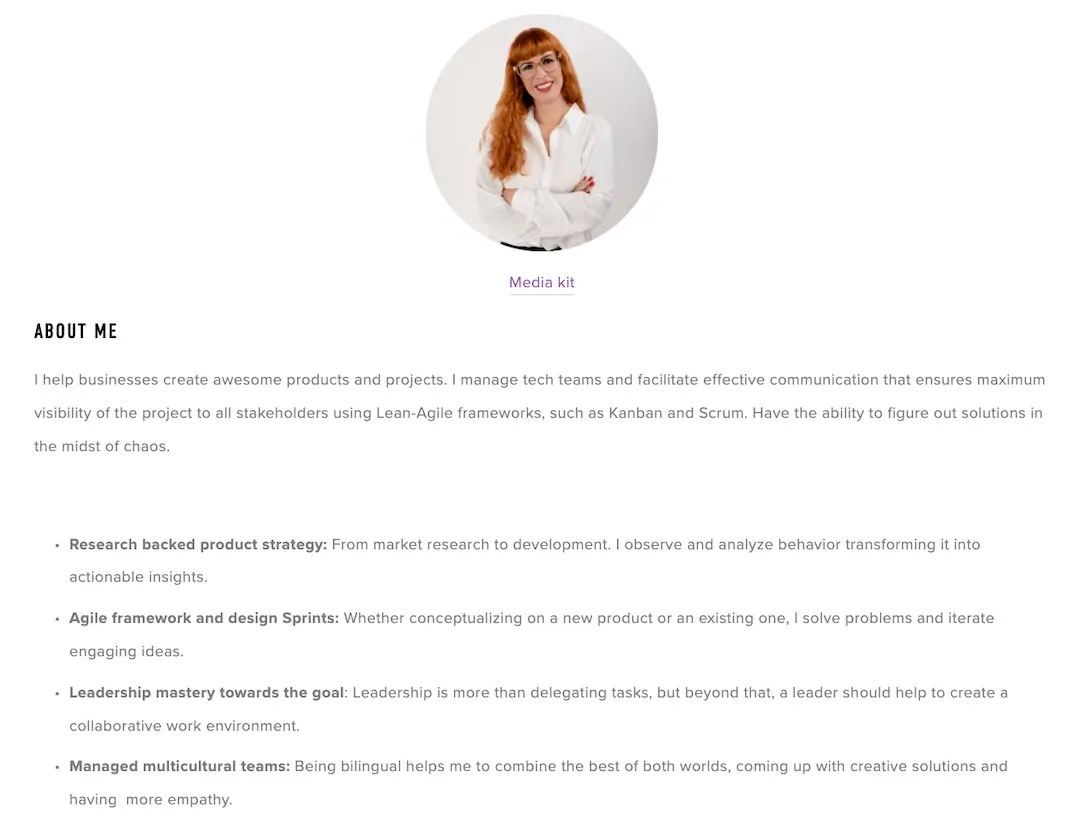
Things we like: Her case studies. Thaisa has been meticulous in laying them out for the user.
On her homepage, each project is introduced in 50-55ish characters. Once you click through to each case study, the opening format of “It all started when…” is really engaging and draws the recruiter in.
Dan Shetty
For those beginner product managers out there, or recent graduates from PM courses, Dan’s an excellent example of how to do a junior PM portfolio.
He shows off from the start where he’s at in his fledgling career, what he’s looking for as a next step, and which projects he’s been working on so far.
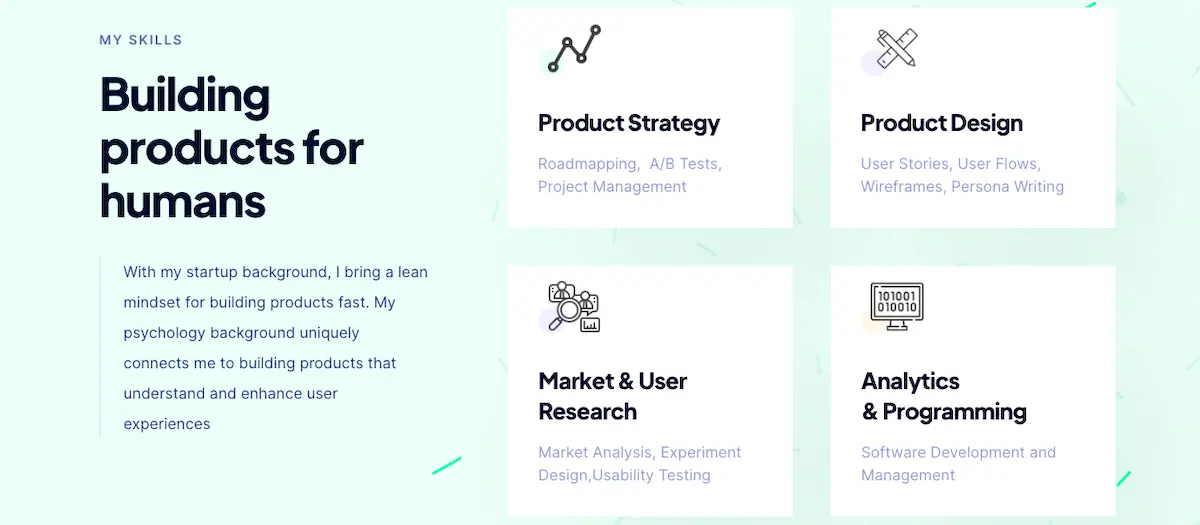
Things we like: In something that will interest career-changers, Dan’s first degree was actually in psychology.
Instead of hiding that, thinking it’s not relevant, he uses it as a USP, stating that his background underpins his product management ethos: building products for humans.
Omolola Odunowu
Another impressive junior product manager portfolio site, Omolola is a multidisciplinary tech worker based in Nigeria.
With only three product case studies to exhibit at present, each is nicely laid out, giving prospective employers the option of either learning about the project or skipping straight to the user flow. Impressive at showing off their thought process, they also have an article explaining why and how they redesigned their portfolio site.
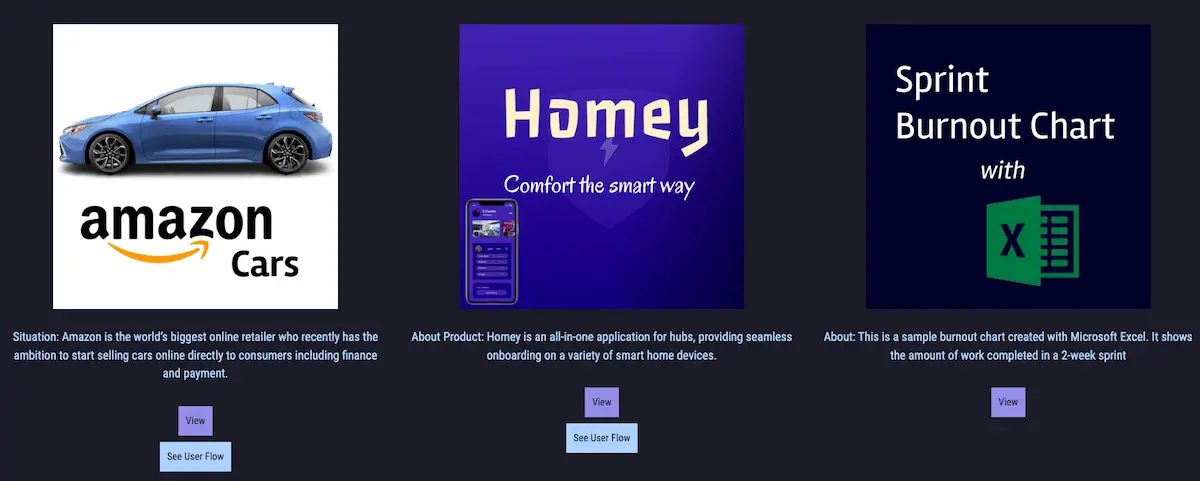
Things we like: Omolola’s CTA button is excellent—a clear link to their email, front-and-center, labeled simply “Hire me”.
Reza Rezaeipour
A man of many talents, Reza has worked hard to design a product manager portfolio on a single-page website that shows off his passion for UX and UI design.
After his introduction, he has his three most important links displayed each with its own CTA—download his up-to-date resume, check out his LinkedIn, and watch his YouTube channel.
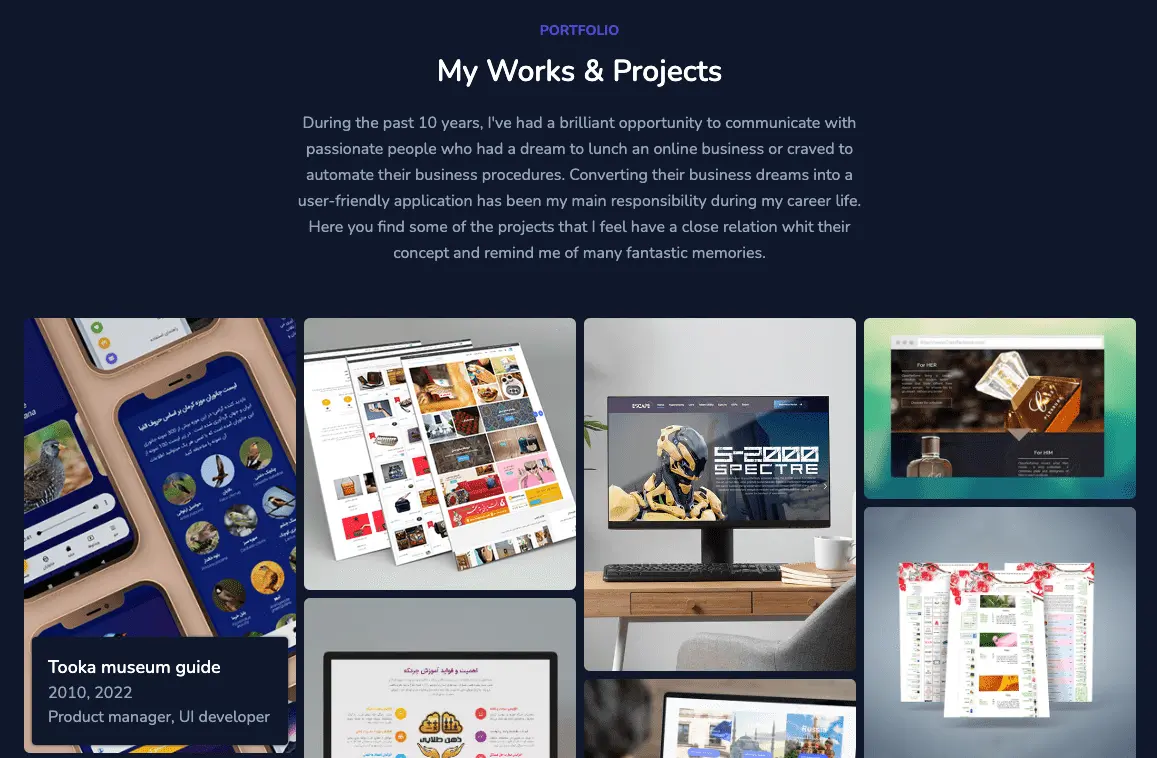
Things we like: Reza’s timeline is a neat way of showing his path while also displaying the various accomplishments and accreditations gained during that time.
Justin Hinh
US-based product manager Justin is a natural storyteller, an approach he takes to explain the case studies in his portfolio.
For those short on time and looking for a TL;DR he provides a Key Takeaways section with the main points.
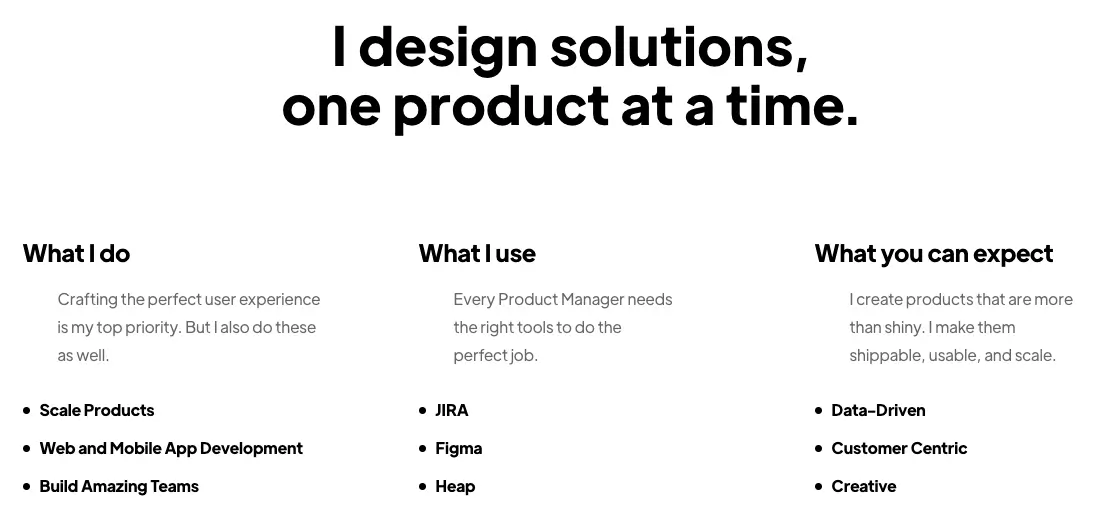
Things we like: Again choosing the bold and clear approach to communication, Justin’s main page is focused on being easy to digest when being scanned.
Using the headings “What I do / What I use / What you can expect”, Justin shares his skills, tools, and professional values as a product manager.
Yuliya Rubtsova
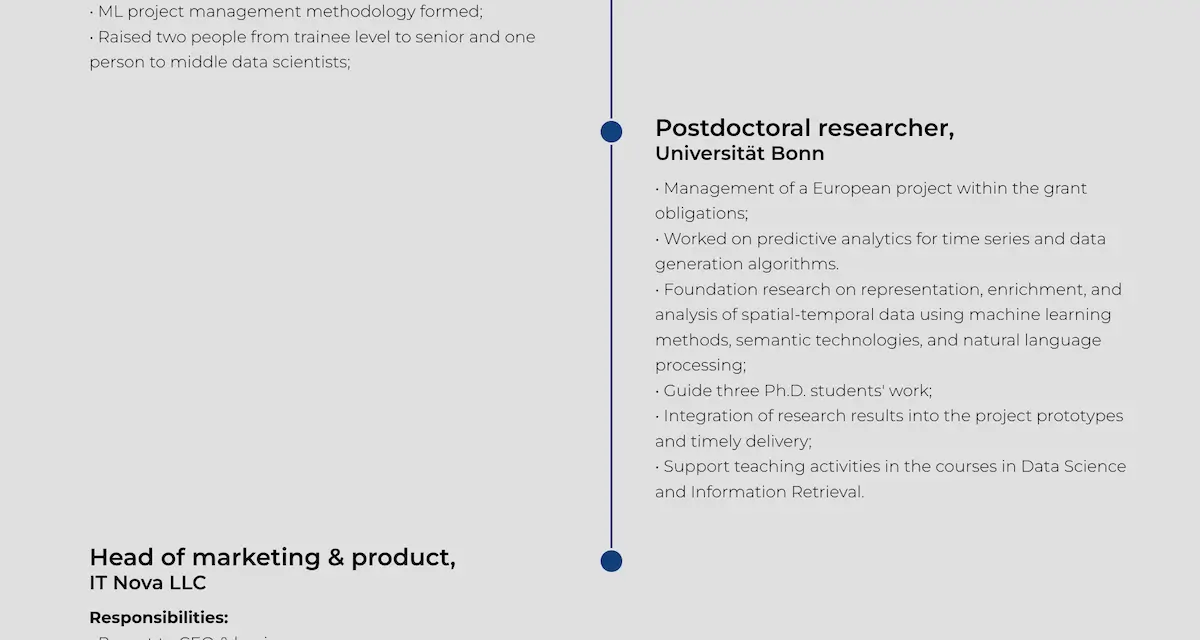
Coming more from the research side of product management, Dr.Yuliya Rubtsova’s professional portfolio site efficiently and clearly displays her academic and commercial work to date.
It showcases a number of projects developed by her where AI and Data Science intersect with product management, such as what an AI product manager might do. These projects are laid out in an easy-to-digest format, with just a few lines sketching the intro/goal, the challenges posed by the project, her own role in it, and the results.
Things we like: Being able to express your career to date in a timeline format on your portfolio is a useful tool for clearly signposting your product management journey. In fact, it’s even more useful for career changers, as it allows you to highlight how you picked up the transferable skills you employ in your current PM career.
Bonus example: Danielle Landry
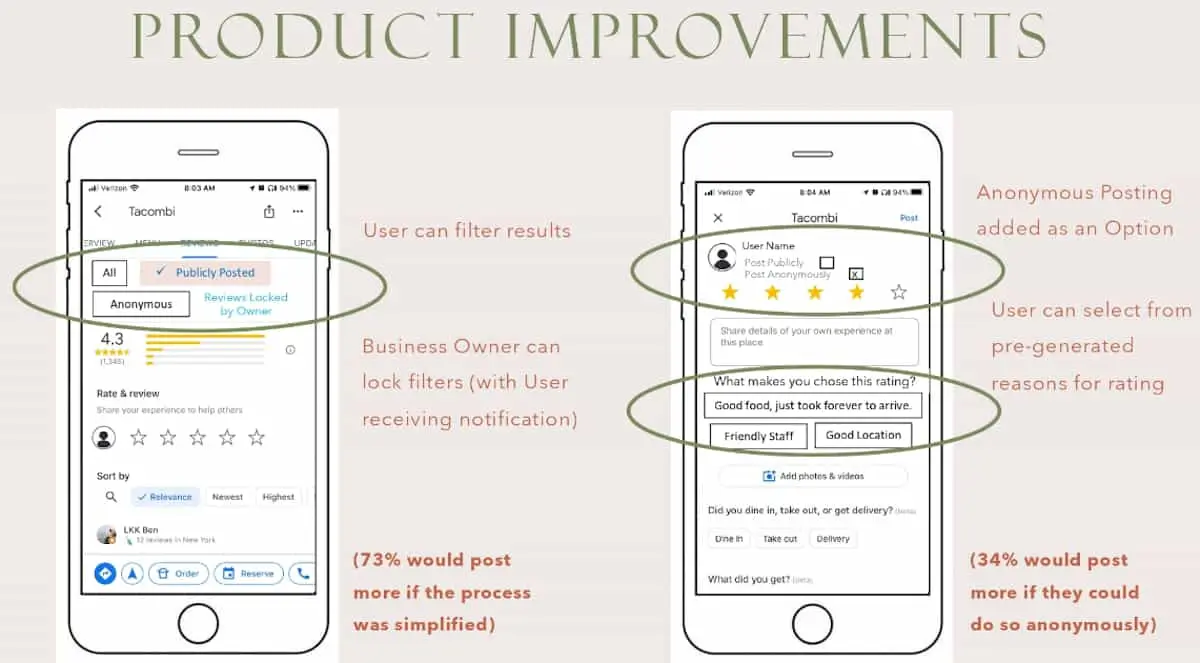
Coming from a background as a film and TV costumer, Danielle allowed some of that visual flair and character knowledge to show in the project she created for the CareerFoundry Intro to Product Management Course.
Things we like: Danielle lays out her project in a clear, engaging, and easily digestible way. The user persona she developed for the task, Nora, is comprehensive and very useful for PMs to spin user stories and scenarios out of.
5. Final thoughts and wrap-up
So there you have it, a complete guide to getting started on your product manager portfolio!
Remember that in general as a product manager your biggest successes are the processes, which you helped to introduce, as well as the results that you achieve.
Be sure that instead of simply showing what happened, to constantly point out your own involvement in the projects and the effect that that had.
In CareerFoundry’s Product Management Program, students will complete several projects as part of the curriculum for their own portfolio.
If you’d like an idea of what one of those will look like, check out Farley Fernandes’s portfolio project from our Intro to Product Management course.
As they approach graduation, they are paired with their own career specialist, an expert with in-depth knowledge of the job market in their area. They’ll actively provide guidance as students refine their portfolio, tune-up their resume, search for and select job postings, and polish their interviewing skills.
If you’d like to learn more about the world of product management, check out these articles:
